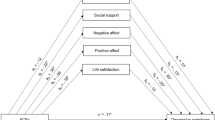Abstract
There are few well validated instruments for measuring the impact of life events and experiences in childhood and adolescence. This study examines the reliability of a new instrument, the Psychosocial Assessment of Childhood Experiences of PACE. Fifteen children and parents were interviewed on two cassions ten days apart for the main test-retest reliability study. About half of the events recorded were reported on both occasions (0.45% and 0.55% concordance). When the impact of specific events was examined much higher levels of agreement were found. Inter-rater reliability tests also yielded higher rate (Kappa 0.74 and above). Possible reasons for these important differences are discussed and the inherent methodological difficulties considered.
Résumé
II y a peu d'instruments correctement validés de mesures de l'impact des événements de vie des expériences dans l'enfance et l'adolescence. Cette étude examine la fiabilité d'un nouvel instrument, l'évaluation psycho-sociale des expériences infantiles (Psychosocial Assessment of Childhood Experiences ou PACE). 15 enfants et parents furent interrogés à deux reprises à 10 jours d'intervalle pour evaluer la fiabilité test-retest. Environ la moitié des événements rapportés le furent dans les deux occasions (0.45% et 0.55% de concordance). Quand l'impact des événements déviés spécifiques fut étudié un niveau plus élevé de concordance fut trouvé. La fidélité inter-cotateurs des tests obtinet également des taux plus élevés (kappa 0.74 et audessus). Les raisons possibles de ces différences sont discutées et les difficultés méthodologiques inhérentes prises en compte.
Zusammenfassung
Es existieren nur wenige gut validierte Meßinstrumente zur Erfassung von Lebensereignissen und Erfahrungen im Kindes- und Jugendalter. Diese Studie untersucht die Reliabilität eines neuen Verfahrens, des Psychosocial Assessment of Childhood Experiences oder PACE. 15 Kinder und Elternteile wurden zweimal im Abstand von 10 Tagen für die Überprüfung der Haupttest-Retest-Reliabilität interviewt. Ca. die Hälfte aller Ereignisse, die beim Interview berichtet wurden, wurdem beim Zweitinterview ebenfalls angegeben (Konkordanzen 0,45 und 0.55). Deutlich höhere Übereinstimmungen fanden sich bei Untersuchung der Auswirkungen spezifischer Ereignisse. Die “Inter-Rater”-Reliabilitätstests ergaben ebenfalls höhere Werte (Kappa 0.74). Mögliche Ursachen dieser wichtigen Unterschiede werden unter Berücksichtigung der inhärenten methodischen Schwierigkeiten diskutiert.
Similar content being viewed by others
References
Brown, G. W., Bifulco, A. & Harris, T. O. (1987). Life events, vulnerability and onset of depression: Some refinements.British Journal of Psychiatry, 150, 30–42.
Brown, G. W. & Harris, T. O. (1978).The Social Origins of Depression: A Study of Psychiatric Disorder in Women. London: Tavistock.
Cohen, J. (1968). Weighted Kappa: Nominal scale agreement with provision for scaled disagreement or partial credit.Psychological Medicine, 70, 213–219.
Dise-Lewis, J. E. (1988). The life events and coping inventory: An assessment of stress in children.Psychosomatic Medicine, 50, 484–499.
Goodyer, I. M. (1990).Life Experiences, Development and childhood Psychopathology, Chichester: Wiley.
Goodyer, I. M., Kolvin, I. & Gatzanis, S. (1985). Recent undesirable life events and psychiatric disorder in childhood and adolescence.British Journal of Psychiatry, 147, 517–523.
Johnson, J. H. & McCutcheon, S. M. (1980). Assessing life stress in older children and adolescents: Preliminary findings with the Life Events Checklist. In I. G. Sarason & C. D. Spielberger (Eds.),Stress and Anxiety, Vol. 7. Washington, DC: Hemisphere.
Monck, E. & Dobbs, R. (1985). Measuring life events in an adolescent populations: Methodological issues and related findings.Psychological Medicine, 15, 841–850.
Parry, G., Shapiro, D. A. & Davies, L. (1981). Reliability of life event ratings: An independent replication.British Journal of Clinical Psychology, 20, 133–134.
Paykel, E. S. (1983). Methodological aspects of life events research.Journal of Psychosomatic Research, 27, 341–352.
Rutter, M. & Sandberg, S. (1992). Psychosocial stressors: concepts, causes and effects.European Journal of Child and Adolescent Psychiatry, 1, 3–13.
Sandberg, S., Rutter, M., Giles, S., Owen, A., Champion, L., Nicholls, J., Prior, V., McGuinness, D. & Drinnan, D. (1992). Assessment of psychosocial experiences in childhood: Methodological issues and some illustrative findings.Journal of Child Psychology and Psychiatry (in press).
Steele, G. P., Henderon, S. & Duncan-Jones, P. (1980). The reliability of reporting adverse experiences.Psychological Medicine, 10, 301.
Tennant, C., Smith, A., Bebbington, P. & Hurry, J. (1979). The contextural threast of life events: the concept and its reliability.Psychological Medicine, 9, 525–528.
Author information
Authors and Affiliations
Rights and permissions
About this article
Cite this article
Glen, S., Simpson, A., Drinnan, D. et al. Testing the reliability of a new measure of life events and experiences in childhood: The Psychosocial Assessment of Childhood Experiences (PACE). European Child & Adolescent Psychiatry 2, 98–110 (1993). https://doi.org/10.1007/BF02098865
Issue Date:
DOI: https://doi.org/10.1007/BF02098865




